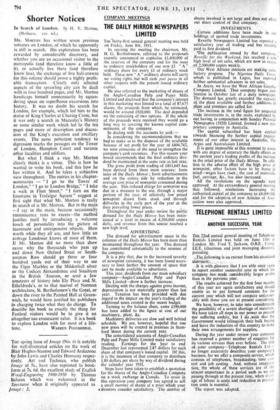Shorter Notices
In Search of London. I3y 11. V. Morton.
(Methuen. I 2S. 6d.)
MR. MORTON has written seven previous volumes on London. of which he apparently is still in search. His exploration has been rewarded by considerable discovery, and whether you are an occasional visitor to the metropolis (and therefore know a little of it), or actually live there (and therefore know less), the exchange of five half-crowns for this volume should prove a highly profit- able transaction.- Clearly only selected aspects of the sprawling city can be dealt with in four hundred pages, and Mr. Morton handicaps himself unnecessarily by squan- dering space on superfluous excursions into history. It was no doubt his search for London, for example, which led him to the statue of King Charles at Charing Cross, but it was only a search in Macaulay's History or some similar work which led to the ten pages and more of description and discus- sion of the King's execution and ancillary events. The same persistent tendency to digression marks the passages on the Tower of London, Hampton Court and various other localities and edifices.
But what I think a vice Mr. Morton Clearly thinks is a virtue. This is how he wanted to write his book, and this how he has written it. And he takes a subjective view throughout. The entries in his chapter- summaries — " I go to the Tower of London," " I go to London Bridge," " I take a walk in Fleet Street," "I turn on the fountains in Trafalgar Square " suggest at first sight that what Mr. Morton is really in search of is Mr. Morton. But in the main —I say in the main, because occasionally reminiscence runs to excess—the method justifies itself by introducing a welcome touch of personality into the picture of inanimate and unresponsive objects. How worth while they all are, and how little an average Londoner knows of most of them. If Mr. Morton did no more than show cause why the thousands who pass up and down New Oxford Street or South- ampton Row should go three or four hundred yards out of their way to see
the Elgin Marbles or the Mildenhall silver or the Codices Alexandrinus and Sinaiticus in the British Auseum, or send a - few amateurs of history into Ely Place and St. Etheldreda's, or to that marvel of Norman
architecture, St. Bartholomew's the Great, or
down the river to the Painted Hall at Green- wich, he would have justified his publishers in charging twice what they do charge. To describe his book as exactly the thing for Festival visitors would be to give it an altogether too evanescent value. It is a book to explore London with for most of a life- time. _ WARREN POSTBRIDGE.


































 Previous page
Previous page